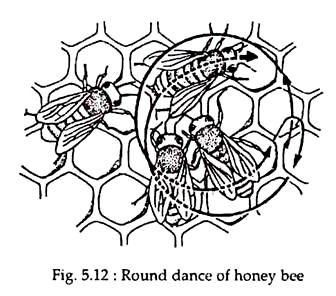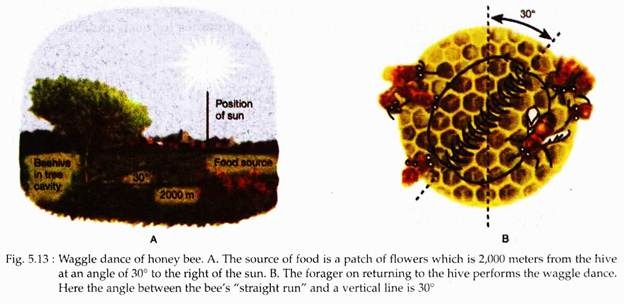Get the answer of: How do Bees Communicate about Food Source ?
Communication System of Bees:
Honey bees have an elaborate communication system to signal to other members of the hive the exact location of the food. The bees feed on the nectar of flowers. Food collection often involves thousands of workers covering large areas of ground.
It is really interesting as to how an individual forager is able to convey to its hive mates the complete information about the food source. Aristotle thought that the bees simply followed the forager to the food.
ADVERTISEMENTS:
However, Karl von Frisch (1967) demonstrated that recruitment takes place even when the forager is not allowed to return from the hive to the food source, von Frisch hypothesized that bees obtain information on the food through odour communicated in the hive by the forager’s ‘dance’.
Members of the hive maintain antennal contact with the dancer’s body and taste samples of regurgitated food, von Frisch later developed his famous dance-language hypothesis.
This dance of the bees is of the following two types:
A. Round Dance:
ADVERTISEMENTS:
If a food source is at short distance (from 20 to 200 meters, depending on the strain of bees) from the hive, returning foragers perform the “Rundtanz” or “Round dance” (Fig 5.12). In this dance the forager performs a series of circles, alternately to the left and right every second or so.
After a short while other bees start following this scout bee and soon they fly off to look for the food and on return they also perform the same dance, thereby increasing the number of foragers.
The first bee also carries the scent of the flower it visited. The round dance facilitates the fellow workers to search the correct food source by comparing the two smells (sample smell provided by the forager and the smell of the target flower).
There is a relation in the duration and liveliness of the dance and the richness of the food source. The richer the food source, the more lively and longer is the duration of the dance. In such a case more and more bees are attracted. When the large number of bees have exhausted the food source, they gradually slow down the dance and, ultimately, stop dancing altogether, signalling the end of the food supply.
ADVERTISEMENTS:
B. Waggle Dance:
If the food source is located at a greater distance, the bees perform another type of dance, the “Schwanzeltanz” or the “Waggle dance”. The waggle dance is shaped in a figure of eight (8), looping first to the left and then to the right with waggling of the abdomen in a straight line. The waggle dance of honeybee was first studied experimentally by Karl von Frisch (1967).
To visualize this dance let us imagine that a worker bee has just returned from a rich food source (bountiful nectar) which is approximately 2,000 meters from her hive and this food source is located 30 degrees to the right of an imaginary straight line running between the worker’s hive and the sun (Fig. 5.13).
On returning to the hive, the forager would quickly start “dancing” up and down a vertical comb within the hive. It orients itself by gravity and substitutes a point directly overhead for the sun. The angle (30° as discussed above) between the sun and the food source is the same as that between a point directly overhead and the food source.
When the forager does her waggle dance, as many sisters as possible try to keep up with her (making as much physical contact as they can, Fig. 5.13B). While dancing vigorously the forager would be conveying crucial information to her sisters in the hive. Thus, her dance would provide topographical information (north, east, north-west etc.) for finding the food source from which she has just returned.
In addition, the longer the bee dances, the further away is the food source. It is likely that every extra 75 milliseconds of dancing would mean that the food source is about an additional 100 meters away from the hive. Moreover, the scent of the returning forager, as well as any food that might be sticking to her body, would provide additional information about the food source.
Bees may dance for long periods if the food source is rich. During this time, the sun may change position in the sky. Like the birds, bees too have a built-in biological clock mechanism which compensates for such changes.
ADVERTISEMENTS:
As the sun’s apparent position changes, so does the direction of the waggle dance. Thus, accurate flight direction is always given. The communication in bee dance is multi- channeled, as touch, smell; vision and sound all play important roles.

